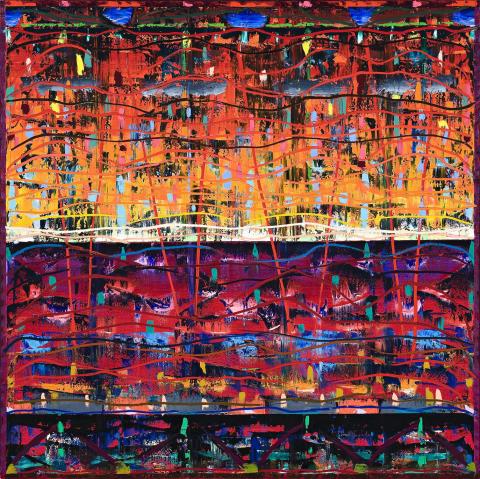AGAINST THE LIGHT, 2002
MICHAEL JOHNSON
oil on canvas
183.0 x 183.0 cm
signed and dated verso: Michael Johnson 2002
inscribed with title on stretcher bar verso: … / TITLE: “AGAINST, THE LIGHT”
Private collection, Sydney
Deutscher and Hackett, Melbourne, 29 April 2009, lot 107
Private collection, Sydney
‘I think that painting is more about feeling than what you see ... I don’t make thick paint for that reason, mind you ... but I think it is about touch ... All painting is invisible in this sense ... We feel our way through life, we don’t see our way through life’.1
Throughout the 1970s Michael Johnson worked with acrylic paints popularised by a generation of American painters. The resulting paintings were disciplined arrangements of shaped canvases which relied on complimentary colour juxtapositions to create the work. In 1981 the artist sheepishly began using oil paint. I say sheepishly as oil paint is encumbered by centuries of tradition and the notion that ‘new work’ needed new materials is a guiding edict for artists who work against the parameters of convention. His late 1980s exhibitions at Macquarie Galleries in Sydney were greeted with great enthusiasm and this fuelled the artist’s already strident presence on the Australian art scene. Each following exhibition would trump the previous for bravado and creative flare. As hungry art students, we would visit the Macquarie Galleries and view the paintings in awe of the sheer energy of the works and the volume of paint he used.
The artist explained his initial reluctance to use oil paint along with some remarks about his subject to Barry Pearce:
I fear oil, even though it is the most natural thing to paint with and I love it. But I fear its trickery. You can get too clever with it. I went through this funny period where I recalled my childhood with the Quasar and Cattai paintings, memories of watching floodwaters bringing debris down to the ocean at little Hallow Beach. I don’t know what the diagonals were about but, without being figurative I was trying to get a feel of association with experience, not place ... and suddenly I could use opaque over-painting as a transparency, and I could veil my paintings and push things back and forwards.2
As if compensating for years of working with inert acrylic surfaces, a dense textured quality created entirely from pure oil paint quickly became a central feature of Johnson’s painting. His forensic understanding of colour honed over many years now fitted his fresh appreciation for the physicality of oil paint, as the density of the paint was matched by that of the pigments. Against the Light, 2002, is a classic example of Johnson’s work, the formal symmetry of the composition and the rhythmic colour, combine with his signature application of paint to create a work of both power and presence.
Johnson’s paintings are closer to the nature of nature itself than they are to any literal aspect of it. They draw upon the ephemeral as much as the literal in nature – the pull of the moon or mood of a tide are as legitimate a subject as any. Calligraphic arabesques are overlayed onto the canvas directly from the tube; these forms are raked back into the surface and then redrawn with paint applied in swathes of oil. Metres of pure paint in even lines come together creating a mesh of colour which provides each work with its individual beauty.
1. Transcript of taped interview with the artist by the Barry Pearce, 13 June 1997, Australian artists archive, Art Gallery of New South Wales Library
2. ibid.
HENRY MULHOLLAND
